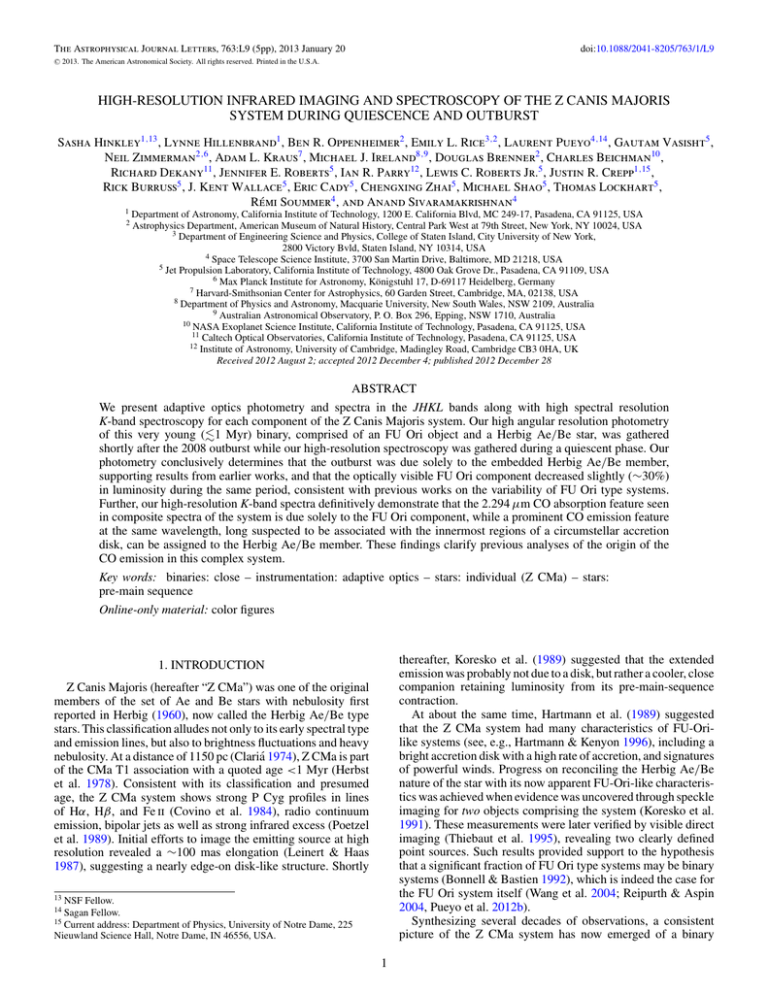
The Astrophysical Journal Letters, 763:L9 (5pp), 2013 January 20
C 2013.
doi:10.1088/2041-8205/763/1/L9
The American Astronomical Society. All rights reserved. Printed in the U.S.A.
HIGH-RESOLUTION INFRARED IMAGING AND SPECTROSCOPY OF THE Z CANIS MAJORIS
SYSTEM DURING QUIESCENCE AND OUTBURST
Sasha Hinkley1,13 , Lynne Hillenbrand1 , Ben R. Oppenheimer2 , Emily L. Rice3,2 , Laurent Pueyo4,14 , Gautam Vasisht5 ,
Neil Zimmerman2,6 , Adam L. Kraus7 , Michael J. Ireland8,9 , Douglas Brenner2 , Charles Beichman10 ,
Richard Dekany11 , Jennifer E. Roberts5 , Ian R. Parry12 , Lewis C. Roberts Jr.5 , Justin R. Crepp1,15 ,
Rick Burruss5 , J. Kent Wallace5 , Eric Cady5 , Chengxing Zhai5 , Michael Shao5 , Thomas Lockhart5 ,
Rémi Soummer4 , and Anand Sivaramakrishnan4
1 Department of Astronomy, California Institute of Technology, 1200 E. California Blvd, MC 249-17, Pasadena, CA 91125, USA
2 Astrophysics Department, American Museum of Natural History, Central Park West at 79th Street, New York, NY 10024, USA
3 Department of Engineering Science and Physics, College of Staten Island, City University of New York,
2800 Victory Bvld, Staten Island, NY 10314, USA
Space Telescope Science Institute, 3700 San Martin Drive, Baltimore, MD 21218, USA
Jet Propulsion Laboratory, California Institute of Technology, 4800 Oak Grove Dr., Pasadena, CA 91109, USA
6 Max Planck Institute for Astronomy, Königstuhl 17, D-69117 Heidelberg, Germany
7 Harvard-Smithsonian Center for Astrophysics, 60 Garden Street, Cambridge, MA, 02138, USA
8 Department of Physics and Astronomy, Macquarie University, New South Wales, NSW 2109, Australia
9 Australian Astronomical Observatory, P. O. Box 296, Epping, NSW 1710, Australia
10 NASA Exoplanet Science Institute, California Institute of Technology, Pasadena, CA 91125, USA
11 Caltech Optical Observatories, California Institute of Technology, Pasadena, CA 91125, USA
12 Institute of Astronomy, University of Cambridge, Madingley Road, Cambridge CB3 0HA, UK
Received 2012 August 2; accepted 2012 December 4; published 2012 December 28
4
5
ABSTRACT
We present adaptive optics photometry and spectra in the JHKL bands along with high spectral resolution
K-band spectroscopy for each component of the Z Canis Majoris system. Our high angular resolution photometry
of this very young (1 Myr) binary, comprised of an FU Ori object and a Herbig Ae/Be star, was gathered
shortly after the 2008 outburst while our high-resolution spectroscopy was gathered during a quiescent phase. Our
photometry conclusively determines that the outburst was due solely to the embedded Herbig Ae/Be member,
supporting results from earlier works, and that the optically visible FU Ori component decreased slightly (∼30%)
in luminosity during the same period, consistent with previous works on the variability of FU Ori type systems.
Further, our high-resolution K-band spectra definitively demonstrate that the 2.294 μm CO absorption feature seen
in composite spectra of the system is due solely to the FU Ori component, while a prominent CO emission feature
at the same wavelength, long suspected to be associated with the innermost regions of a circumstellar accretion
disk, can be assigned to the Herbig Ae/Be member. These findings clarify previous analyses of the origin of the
CO emission in this complex system.
Key words: binaries: close – instrumentation: adaptive optics – stars: individual (Z CMa) – stars:
pre-main sequence
Online-only material: color figures
thereafter, Koresko et al. (1989) suggested that the extended
emission was probably not due to a disk, but rather a cooler, close
companion retaining luminosity from its pre-main-sequence
contraction.
At about the same time, Hartmann et al. (1989) suggested
that the Z CMa system had many characteristics of FU-Orilike systems (see, e.g., Hartmann & Kenyon 1996), including a
bright accretion disk with a high rate of accretion, and signatures
of powerful winds. Progress on reconciling the Herbig Ae/Be
nature of the star with its now apparent FU-Ori-like characteristics was achieved when evidence was uncovered through speckle
imaging for two objects comprising the system (Koresko et al.
1991). These measurements were later verified by visible direct
imaging (Thiebaut et al. 1995), revealing two clearly defined
point sources. Such results provided support to the hypothesis
that a significant fraction of FU Ori type systems may be binary
systems (Bonnell & Bastien 1992), which is indeed the case for
the FU Ori system itself (Wang et al. 2004; Reipurth & Aspin
2004, Pueyo et al. 2012b).
Synthesizing several decades of observations, a consistent
picture of the Z CMa system has now emerged of a binary
1. INTRODUCTION
Z Canis Majoris (hereafter “Z CMa”) was one of the original
members of the set of Ae and Be stars with nebulosity first
reported in Herbig (1960), now called the Herbig Ae/Be type
stars. This classification alludes not only to its early spectral type
and emission lines, but also to brightness fluctuations and heavy
nebulosity. At a distance of 1150 pc (Clariá 1974), Z CMa is part
of the CMa T1 association with a quoted age <1 Myr (Herbst
et al. 1978). Consistent with its classification and presumed
age, the Z CMa system shows strong P Cyg profiles in lines
of Hα, Hβ, and Fe ii (Covino et al. 1984), radio continuum
emission, bipolar jets as well as strong infrared excess (Poetzel
et al. 1989). Initial efforts to image the emitting source at high
resolution revealed a ∼100 mas elongation (Leinert & Haas
1987), suggesting a nearly edge-on disk-like structure. Shortly
13
NSF Fellow.
Sagan Fellow.
15 Current address: Department of Physics, University of Notre Dame, 225
Nieuwland Science Hall, Notre Dame, IN 46556, USA.
14
1
The Astrophysical Journal Letters, 763:L9 (5pp), 2013 January 20
Hinkley et al.
Table 1
Table of Observations
Object
Star Type
Date
Z CMa State
Observatory and Instrument
Wavelengths
(μm)
Mode
Z CMa
S Mon
Z CMa
HD 53455
HD 75898
Z CMa
HD 112196
Target
Calibrator
Target
Calibrator
Calibrator
Target
Calibrator
2006 Dec 17
2006 Dec 17
2008 Dec 21
2008 Dec 21
2008 Dec 21
2009 Mar 17
2009 Mar 17
Quiescence
···
Outburst
···
···
Outburst
···
Keck: NIRSPEC
Keck: NIRSPEC
Keck: NIRC2
Keck: NIRC2
Keck: NIRC2
Palomar: Project 1640
Palomar: Project 1640
2.10–2.13, 2.29–2.32
2.10–2.13, 2.29–2.32
1.57–3.32
1.57–3.32
1.57–3.32
1.06–1.76
1.06–1.76
Spectroscopy
Spectroscopy
Imaging
Imaging
Imaging
Spectrophotometry
Spectrophotometry
2. OBSERVATIONS AND DATA PROCESSING
system comprised of a FU-Ori-like object which dominates the
optical emission and a Herbig Ae/Be object which dominates
the infrared (Whitney et al. 1993; van den Ancker et al. 2004).
The terminology used for each component in the system in past
literature has been somewhat ambiguous given the constantly
evolving physical understanding of this remarkable system. As
such, in this work we have chosen to abandon the “primary”
and “secondary” nomenclature that pervades the literature, and
instead use the terms “Z CMa Southeast (SE)” to refer to the
FU Ori component and “Z CMa Northwest (NW),” referring to
Herbig Ae/Be component. Koresko et al. (1991) show that
the SE component dominates the emission of the NW component blueward of 2 μm, and vice versa for wavelengths longer
than 2 μm.
Support for the basic physical picture of the system has been
verified repeatedly over the past 10 years, i.e., the identification that the SE component is a ∼few M object (van den
Ancker et al. 2004) responsible for the jet/outflow phenomena
(Millan-Gabet & Monnier 2002), while the NW component
has considerable evidence supporting its Herbig Ae/Be nature including emission lines and a compact, massive envelope
(Whitney et al. 1993). This system experienced a significant
outburst in 2008 (e.g., Grankin & Artemenko 2009) lasting
∼1.5 years, and was photometrically monitored extensively
at X-ray to visible wavelengths (Malbet et al. 2010). Indeed,
using spectropolarimetry of the system, Szeifert et al. (2010)
claimed the outburst was associated with the Herbig Ae/Be
component of the system. Further, while dual-imaging polarimetry has typically been reserved for young circumstellar
disk systems (e.g., Oppenheimer et al. 2008; Hinkley et al.
2009), recently Canovas et al. (2012) have used this technique to identify the jets associated with each member of this
system.
Near-infrared spectroscopy of the Z CMa system has been
scarce over the past 30 years. Indeed, as Antoniucci et al.
(2009) point out, only Liljestroem & Olofsson (1997) and
van den Ancker et al. (2004) have provided previous nearinfrared spectra. In this Letter, we present near-IR spectra
and/or photometry in the JHKL bands for both components
during the 2008 outburst, resolved using high angular resolution imaging (Oppenheimer & Hinkley 2009), as well as
archival photometry covering the same bandpasses (Koresko
et al. 1991) for comparison. Our adaptive optics (“AO”) measurements directly demonstrate and provide confirmation of previous work (e.g., Szeifert et al. 2010; Malbet et al. 2010) that
suggested the outburst is due to the Herbig Ae/Be component,
although the exact mechanism of the brightening of this member remains unknown. Moreover, we present high-resolution
K-band spectra of each member of the binary obtained in
2006 during the quiescent phase. Table 1 provides a list of our
observations.
Our high angular resolution observations of Z CMa were
taken using Palomar/P1640 and Keck/NIRC2 AO during
outburst. Our AO-assisted K-band spectroscopy was taken
with Keck/NIRSPEC in quiescence. Table 1 provides a
summary.
2.1. JHKL-band Spectra and Photometry During Outburst
We imaged the Z CMa system in its high state on
UT 2009 March 17 using “Project 1640” (Hinkley et al. 2011c;
Oppenheimer et al. 2012) on the 200 inch Hale Telescope at
Palomar Observatory. Project 1640 is a coronagraph integrated
with an integral field spectrograph (IFS). The IFS+Coronagraph
package is mounted on the Palomar AO system (Dekany et al.
1998), which in turn is mounted at the Cassegrain focus of the
Hale Telescope. The coronagraph is an Apodized-Pupil Lyot
coronagraph (Sivaramakrishnan et al. 2001; Soummer 2005),
having a 370 mas diameter (5.37λ/D at H band) focal plane
mask. The IFS is a microlens-based imaging spectrograph
which can simultaneously obtain ∼40,000 spectra across our
3. 8 × 3. 8 field of view. Each microlens subtends 19.2 mas on
the sky and a dispersing prism provides a spectral resolution
(λ/Δλ) ∼ 45. The observing wavelengths spanned the J and H
bands (1.06–1.76 μm at the time of these observations). Early
examples of spectrophotometry and astrometry from this project
can be found in Hinkley et al. (2010, 2011b), Zimmerman et al.
(2010), Roberts et al. (2012), and Pueyo et al. (2012b). While
an IFS clearly aids in spectral characterization, it can also improve sensitivity (Crepp et al. 2011; Pueyo et al. 2012a) through
the suppression of quasi-static speckle noise, which will limit
high contrast observations (Hinkley et al. 2007). This system
is also equipped with aperture masking interferometry capabilities (e.g., Hinkley et al. 2011a; Kraus & Ireland 2012) for the
characterization of systems with very small angular separations,
although this technique was not employed in this study.
Three individual wavelength channels are shown in Figure 1.
To fully resolve both members of the system, the target was
observed ∼1 away from the coronagraphic mask. Pointspread function (PSF) fitting photometry was performed in
each of the 23 wavelength channels using a calibration star,
HD 112196 (F8V, V = 7.01), obtained on the same night with
similar signal-to-noise and observed at similar airmass. The
100 mas angular separation of the two Z CMa components
(Figure 1) is only slightly larger than the 70 mas H-band
diffraction limit of the Palomar Hale Telescope. Given this
fact, fitting the empirical calibration PSF star to each member
was performed simultaneously. Each channel of the Z CMa
images was oversampled by a factor of five, and the calibration
PSF was fit to each Z CMa component to determine peak
brightness and centroid positions. Once these two best-fit
2
The Astrophysical Journal Letters, 763:L9 (5pp), 2013 January 20
1.11
milliarcsec
250
m
Hinkley et al.
1.44
m
1.71
m
Herbig AeBe ("NW")
FU Ori ("SE")
0
N
−250
N
E
−250
0
250
milliarcsec
N
E
−250
0
250
milliarcsec
E
−250
0
250
milliarcsec
Figure 1. Three panels showing the Z CMa system shortly after its 2008 outburst at 1.11, 1.44, and 1.71 μm, obtained using the “Project 1640” Integral Field
Spectrograph at Palomar Observatory (Hinkley et al. 2011c). The two members of this system are separated by ∼1.5 Palomar near-infrared diffraction widths. At
longer wavelengths, the northwest member, often referred to as a “Herbig Ae/Be” object, dominates the emission over the southeast member, the “FU Orionis” object.
(A color version of this figure is available in the online journal.)
PSFs were determined, each was subsequently subtracted from
their corresponding Z CMa component to determine the postsubtraction residual flux. This residual flux is the dominant term
in the calculation of the uncertainties in the J- and H-band
spectra.
To avoid saturation on such a bright target, the outburst
data obtained with NIRC2 at Keck Observatory on UT 2008
December 21 utilized the Jcont , Hcont , Kcont , and polycyclic
aromatic hydrocarbon narrow filters with central wavelengths
1.213 μm, 1.580 μm, 2.271 μm, and 3.290 μm, respectively.
The flux values in these narrower filters were then scaled to
corresponding broadband JHKL wavelengths using the ratio
of bandpasses between the two sets. The Z CMa system was
observed using three-point dithering, and airmass corrected
using the calibration stars listed in Table 1.
The left panel of Figure 2 shows the photometry of each
component in the quiescent state collected from Koresko et al.
(1991) using speckle interferometric observations. The right
panel of Figure 2 shows our J- and H-band R ∼ 45 spectra
from Palomar, as well as our HKL-band photometry obtained at
Keck for both members of the system taken from the 2008–2009
outburst observations.
further calibration was derived from internal arc line lamps and
flat-field lamps. Figure 3 shows the flux from two echelle orders
from NIRSPEC, spanning 2.10–2.13 μm and 2.29–2.32 μm.
3. RESULTS
3.1. Confirmation of the Outbursting Component
The quiescent flux measurements taken from Koresko et al.
(1991) and shown in Figure 2 reveal that shortward of ∼2 μm,
the overall system flux is dominated by the SE component (blue
curve in Figure 2). Longward of ∼2 μm, the NW component
(the Herbig Ae/Be star shown by the red points) dominates.
Further, the NW component has increased in brightness during
outburst by an order of magnitude over the quiescent values.
At the same time, we find a ∼30% flux decline between the
quiescent and outburst states for the SE component (the FU Ori
star), shown in blue. The high angular resolution afforded by
the Keck and Palomar AO systems allows us to confirm the
claim (Malbet et al. 2010; Benisty et al. 2010; Szeifert et al.
2010) that the NW component is responsible for the ensemble
system’s increase in brightness.
3.2. Two-component Model Fits to Data
2.2. High-resolution K-band Spectroscopy During Quiescence
Using the photometry obtained at Keck and Palomar, as
well as the work of Koresko et al. (1991), we are able to
satisfactorily fit two-component, reddened, blackbody models
to the quiescent and outburst spectral energy distributions for
each member of the Z CMa system shown in Figure 2. For the
NW component, our model that is physically plausible for such
a luminous star is made up of two blackbodies of temperatures
8500 and 1100 K behind AV = 10. For the SE member, we
find a physical match using components of 5500 and 900 K
behind AV = 5.2. The reddening uses an optical total-to-selective
extinction ratio, Rv = 3.1, and the Mathis (1990) extinction
curve. Although we have chosen to refrain from assigning a great
deal of physical meaning to this two-component model, we refer
to these components as “photosphere” and “disk.” In each of the
quiescent and outburst phases, the disk blackbody temperatures,
normalizations, and reddening values are identical. At the same
time, the normalization of the fit to the photospheric component
Spatially resolved K-band spectra of the two Z CMa components were obtained with the NIRSPEC spectrograph mounted
behind the AO system on the W. M. Keck II telescope
(Wizinowich et al. 2000) on UT 2006 December 17. The
K-band setup provided wavelength coverage across the CO band
head, the Brγ line, an He i line, and an Mg i and Al i metallic
line region, but the spectral coverage is not continuous. The
R = λ/Δλ ∼ 25,000 observations were obtained at two position angles: 60◦ (along the jet axis) and 120◦ (along the projected
semimajor axis of the binary). The slit was 2. 26 long and data
were taken using two different widths: 0. 068 and 0. 027. MCDS
readout mode was used with 30 s and 60 s integration times with
five co-adds. Because of the complexity of the field, in addition
to dithered pairs of spectra taken in an ABBA nod pattern, offtarget sky images were also obtained. Telluric correction was
achieved using the rapidly rotating early-type star S Mon and
3
The Astrophysical Journal Letters, 763:L9 (5pp), 2013 January 20
Hinkley et al.
Figure 2. Left: spectral energy distributions of each component of the Z CMa system in the quiescent state taken from Koresko et al. (1991). The NW (Herbig Ae/Be)
component is shown with the red points, while the photometry for the SE member (FU Ori) is shown in blue. Right: in the same color scheme, 1.06–1.76 μm outburst
spectra obtained from the Palomar Project 1640 spectrograph on 2009 March 17 (open circles), as well as HKL Keck/NIRC2 points obtained on 2008 December 21
indicated by star-shaped points. Each solid curve represents two-component models comprised of the sum of two reddened blackbodies shown by dotted and dashed
lines. The 2008 outburst of this system is conclusively due to the order-of-magnitude brightness increase by the Herbig Ae/Be component.
(A color version of this figure is available in the online journal.)
of the NW member has increased by an order of magnitude from
quiescence to outburst, while for the SE component, it has been
reduced by 30% between the two stages. The inherent variability
of the Z CMa system is reflected in these changing photosphere
normalizations.
Figure 2 shows that in addition to the order-of-magnitude
brightness increase of the NW component, the peak luminosity
of this member has shifted blueward, indicating either a greater
luminosity of the photospheric component or a significant
decrease in the AV value. However, decreasing the AV value
immediately requires unphysical values for the photospheric
temperature. Specifically, AV = 2 for the NW component implies
an unphysical best-fit photosphere temperature of ∼1300 K. The
5500 K photospheric temperature for the SE member agrees well
with typical FU Ori objects that show CO absorption features
(See Section 3.3) as described, for example, in Calvet et al.
(1991). Meanwhile, the disk temperature for the NW member
agrees well with values quoted in Szeifert et al. (2010). Lastly,
this ∼30% decrease in flux for the SE component over ∼20 years
is remarkably similar to the optical decay reported in Clarke et al.
(2005) for the prototypical system FU Ori.
3.3. CO Features Observed in Quiescence
Figure 3. Keck K-band spectra from the NIRSPEC spectrograph for both the
SE and NW components of Z CMa obtained while the system was in quiescence
on 2006 December 17. The Herbig Ae/Be component shows a prominent CO
emission feature located at 2.293 μm, while the FU Ori component shows a
significant absorption at this wavelength.
The NIRSPEC spectra shown in Figure 3 capture the prominent He i emission line at 2.113 μm as well as the CO band
head at 2.294 μm. CO emission in this wavelength range occurs
in ∼20% of luminous young stellar systems (e.g., Carr 1989),
and probes the innermost regions of the circumstellar accretion
disks (Najita et al. 2008).
Our Keck high angular resolution observations allow us to
determine that the SE component (the FU Ori star) possesses
a significant CO band head absorption at 2.294 μm. Several
FU Ori objects such as FU Ori itself, V1057 Cyg, and V1515
Cyg show significant absorption features due to this CO band
head (e.g., Reipurth & Aspin 1997). It has been noted that Z CMa
possesses rather weak CO absorption at 2.294 μm relative to
other FU Ori stars, attributed to mixing of the signals between
the two components due to inadequate angular resolution
(Hartmann & Kenyon 1996). We can check this hypothesis with
our high angular resolution observations. Our clear detection
of the absorption band head at 2.294 μm in the SE component
confirms the claim of van den Ancker et al. (2004) that the
absorption is most likely arising from this component. While
Liljestroem & Olofsson (1997) present evidence for the CO band
4
The Astrophysical Journal Letters, 763:L9 (5pp), 2013 January 20
Hinkley et al.
herein were obtained at the W. M. Keck Observatory, which
is operated as a scientific partnership among the California Institute of Technology, the University of California, and NASA.
The Observatory was made possible by the generous financial
support of the W. M. Keck Foundation.
head using medium resolution K-band spectra (see especially
their Figure 1), the spectral resolution of their observations
was not sufficient to ascribe these CO band head features to
one component or the other. Indeed, these authors attempt a
decomposition of the spectrum by choosing a linear analytic
function for the NW component, which forces deviations from
this linear form to be due to the SE component.
At the same time, Figure 3 shows that the NW companion
(the Herbig Ae/Be) shows an emission feature at the band head
location. Malbet et al. (2010) and Benisty et al. (2010) note the
presence of this CO overtone line in emission during outburst
in their spatially unresolved observations of the Z CMa system.
Our high spectral resolution observations clearly demonstrate
the CO emission arises from the NW component. Calvet et al.
(1991) discuss at length the conditions under which an object
may exhibit CO emission during an outburst phase through the
increased irradiation of the atmosphere of the circumstellar disk.
REFERENCES
Antoniucci, S., Arkharov, A. A., Giannini, T., et al. 2009, ATel, 2024, 1
Benisty, M., Malbet, F., Dougados, C., et al. 2010, A&A, 517, L3
Bonnell, I., & Bastien, P. 1992, ApJL, 401, 31
Calvet, N., Patino, A., Magris, G. C., & D’Alessio, P. 1991, ApJ, 380, 617
Canovas, H., Min, M., Jeffers, S. V., Rodenhuis, M., & Keller, C. U. 2012, A&A,
543, A70
Carr, J. S. 1989, ApJ, 345, 522
Clariá, J. J. 1974, A&A, 37, 229
Clarke, C., Lodato, G., Melnikov, S. Y., & Ibrahimov, M. A. 2005, MNRAS,
361, 942
Covino, E., Terranegra, L., Vittone, A. A., & Russo, G. 1984, AJ, 89, 1868
Crepp, J. R., Pueyo, L., Brenner, D., et al. 2011, ApJ, 729, 132
Dekany, R. G., Brack, G., Palmer, D., et al. 1998, Proc. SPIE, 3353, 56
Grankin, K. N., & Artemenko, S. A. 2009, IBVS, 5905, 1
Hartmann, L., & Kenyon, S. J. 1996, ARA&A, 34, 207
Hartmann, L., Kenyon, S. J., Hewett, R., et al. 1989, ApJ, 338, 1001
Herbig, G. H. 1960, ApJS, 4, 337
Herbst, W., Racine, R., & Warner, J. W. 1978, ApJ, 223, 471
Hinkley, S., Carpenter, J. M., Ireland, M. J., & Kraus, A. L. 2011a, ApJL,
730, 21
Hinkley, S., Monnier, J. D., Oppenheimer, B. R., et al. 2011b, ApJ, 726, 104
Hinkley, S., Oppenheimer, B. R., Brenner, D., et al. 2010, ApJ, 712, 421
Hinkley, S., Oppenheimer, B. R., Soummer, R., et al. 2009, ApJ, 701, 804
Hinkley, S., Oppenheimer, B. R., Soummer, R., et al. 2007, ApJ, 654, 633
Hinkley, S., Oppenheimer, B. R., Zimmerman, N., et al. 2011c, PASP,
123, 74
Koresko, C. D., Beckwith, S. V. W., Ghez, A. M., Matthews, K., & Neugebauer,
G. 1991, AJ, 102, 2073
Koresko, C. D., Beckwith, S. V. W., & Sargent, A. I. 1989, AJ, 98, 1394
Kraus, A. L., & Ireland, M. J. 2012, ApJ, 745, 5
Leinert, C., & Haas, M. 1987, A&A, 182, L47
Liljestroem, T., & Olofsson, G. 1997, ApJ, 478, 381
Malbet, F., Benisty, M., Dougados, C., et al. 2010, Proc. SPIE, 7734, 773427
Mathis, J. S. 1990, ARA&A, 28, 37
Millan-Gabet, R., & Monnier, J. D. 2002, ApJL, 580, 167
Najita, J. R., Crockett, N., & Carr, J. S. 2008, ApJ, 687, 1168
Oppenheimer, B. R., Beichman, C., Brenner, D., et al. 2012, Proc. SPIE, 8447,
844720
Oppenheimer, B. R., Brenner, D., Hinkley, S., et al. 2008, ApJ, 679, 1574
Oppenheimer, B. R., & Hinkley, S. 2009, ARA&A, 47, 253
Poetzel, R., Mundt, R., & Ray, T. P. 1989, A&A, 224, L13
Pueyo, L., Crepp, J. R., Vasisht, G., et al. 2012a, ApJS, 199, 6
Pueyo, L., Hillenbrand, L., Vasisht, G., et al. 2012b, ApJ, 757, 57
Reipurth, B., & Aspin, C. 1997, AJ, 114, 2700
Reipurth, B., & Aspin, C. 2004, ApJL, 608, 65
Roberts, L. C., Jr., Rice, E. L., Beichman, C. A., et al. 2012, AJ, 144, 14
Sivaramakrishnan, A., Koresko, C. D., Makidon, R. B., Berkefeld, T., &
Kuchner, M. J. 2001, ApJ, 552, 397
Soummer, R. 2005, ApJL, 618, 161
Szeifert, T., Hubrig, S., Schöller, M., et al. 2010, A&A, 509, L7
Thiebaut, E., Bouvier, J., Blazit, A., et al. 1995, A&A, 303, 795
van den Ancker, M. E., Blondel, P. F. C., Tjin A Djie, H. R. E., et al.
2004, MNRAS, 349, 1516
Wang, H., Apai, D., Henning, T., & Pascucci, I. 2004, ApJL, 601, 83
Whitney, B. A., Clayton, G. C., Schulte-Ladbeck, R. E., et al. 1993, ApJ,
417, 687
Wizinowich, P., Acton, D. S., Shelton, C., et al. 2000, PASP, 112, 315
Zimmerman, N., Oppenheimer, B. R., Hinkley, S., et al. 2010, ApJ, 709, 733
4. CONCLUSIONS
We present high angular resolution near-infrared observations
of the Z Canis Majoris system during its 2008 outburst as well as
prior to this during a quiescent phase. The JHKL-band outburst
photometry conclusively determines (1) that the brightening is
due solely to the embedded Herbig Ae/Be member, confirming results from earlier works, and (2) that the optically visible
FU Ori component has actually experienced slightly declining
brightness between the quiescent and outburst stages. Thus, this
substantial brightness increase of the Herbig Ae/Be component relative to its quiescent state is responsible for the continuum brightness doubling of the ensemble system. Further, the
Keck high-resolution K-band spectra obtained during a quiescent phase allow us to conclusively determine that the 2.294 μm
CO absorption feature seen in composite spectra of the system is
due solely to the FU Ori component. In addition, however, these
K-band observations show a prominent CO emission feature
in the Herbig Ae/Be member which likely dilutes the strength
of the corresponding absorption feature in the SE component
when the images of each component are blended with lower angular resolution observations. This result provides clarification
of the source of the CO emission presented in other works (e.g.,
Benisty et al. 2010; Malbet et al. 2010).
This work was performed in part under contract with the
California Institute of Technology (Caltech) funded by NASA
through the Sagan Fellowship Program. A portion of this
work was supported by the National Science Foundation under
grant Nos. AST-1203023, AST-0804417, 0334916, 0215793,
0520822, and 1245018. A portion of the research in this
Letter was carried out at the Jet Propulsion Laboratory,
California Institute of Technology, under a contract with the
National Aeronautics and Space Administration, and was
funded by internal Research and Technology Development
funds. The authors thank Pat Hartigan for his help obtaining the
Keck/NIRSPEC observations. Some of the data presented
5
ulrichsweb.com(TM) -- The Global Source for Periodicals
1 of 1
http://ulrichsweb.serialssolutions.com/title/1309151286244/695756
Log in to My Ulrich's
Macquarie University Library
Search
Workspace
Ulrich's Update
Admin
Enter a Title, ISSN, or search term to find journals or other periodicals:
2041-8205
Advanced Search
Find in:
Search Results
Search My Library's Catalog: ISSN Search | Title Search
The Astrophysical Journal. Letters
Title Details
Related Titles
Save to List
Alternative Media
Edition (1)
Email
Download
Print
Corrections
Title
The Astrophysical Journal. Letters
ISSN
2041-8205
Publisher
Institute of Physics Publishing Ltd.
Country
United Kingdom
Status
Active
Search History
Start Year
2010
2041-8205
Frequency
18 times a year
0004-637X
Language of Text
Text in: English
0076-2997
Refereed
Yes
1474-7049
Abstracted / Indexed
Yes
1558-8599
Serial Type
Journal
0165-2427
Content Type
Academic / Scholarly
Lists
Marked Titles (0)
0172-7761
0004-6361
0026-1394
0002-9599
0065-2598
Print
Website
http://iopscience.iop.org/2041-8205
Email
apjletters@iop.org
Description
Features papers across the breadth of astronomy and astrophysics.
Subject Classifications
1556-6013
Additional Title Details
0018-9545
Publisher & Ordering Details
ocean science
Price Data
1947-9344
Online Availability
Save to List
Privacy Policy |
Collapse All
Format
0163-6804
Contact Us |
Expand All
Basic Description
Terms and Conditions |
Email
Download
Print
Corrections
Expand All
Collapse All
Accessibility
Ulrichsweb.com™, Copyright © 2011 ProQuest LLC. All Rights Reserved
27/06/2011 3:08 PM






